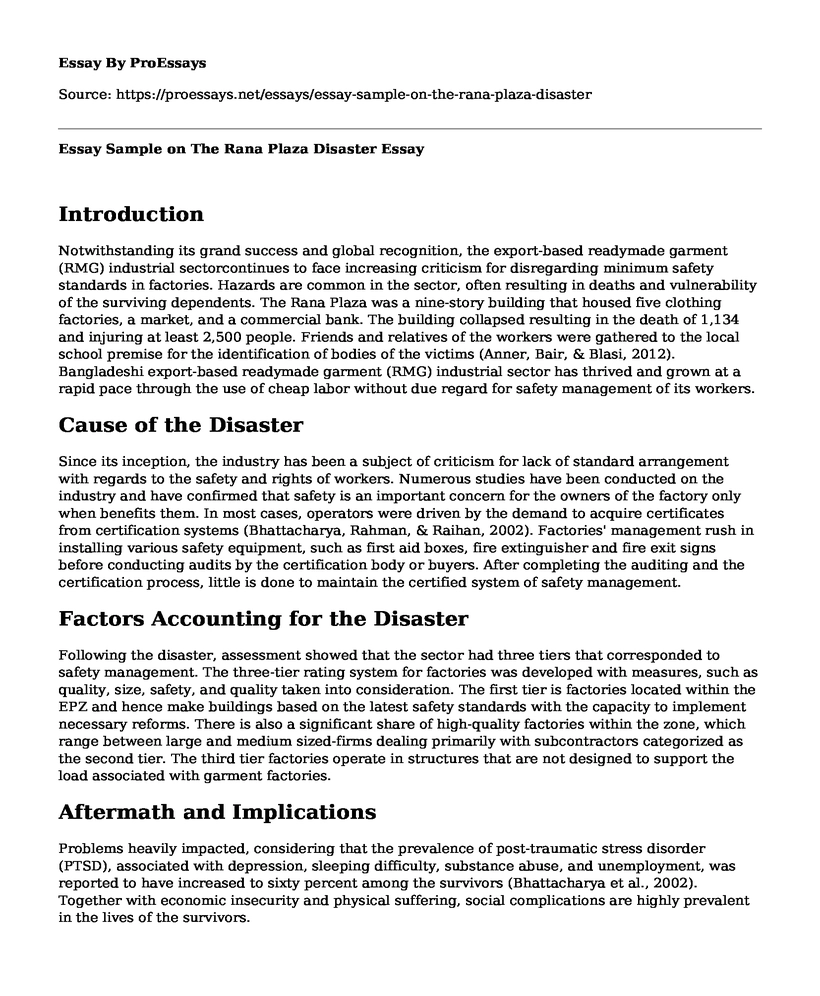Introduction
Notwithstanding its grand success and global recognition, the export-based readymade garment (RMG) industrial sectorcontinues to face increasing criticism for disregarding minimum safety standards in factories. Hazards are common in the sector, often resulting in deaths and vulnerability of the surviving dependents. The Rana Plaza was a nine-story building that housed five clothing factories, a market, and a commercial bank. The building collapsed resulting in the death of 1,134 and injuring at least 2,500 people. Friends and relatives of the workers were gathered to the local school premise for the identification of bodies of the victims (Anner, Bair, & Blasi, 2012). Bangladeshi export-based readymade garment (RMG) industrial sector has thrived and grown at a rapid pace through the use of cheap labor without due regard for safety management of its workers.
Cause of the Disaster
Since its inception, the industry has been a subject of criticism for lack of standard arrangement with regards to the safety and rights of workers. Numerous studies have been conducted on the industry and have confirmed that safety is an important concern for the owners of the factory only when benefits them. In most cases, operators were driven by the demand to acquire certificates from certification systems (Bhattacharya, Rahman, & Raihan, 2002). Factories' management rush in installing various safety equipment, such as first aid boxes, fire extinguisher and fire exit signs before conducting audits by the certification body or buyers. After completing the auditing and the certification process, little is done to maintain the certified system of safety management.
Factors Accounting for the Disaster
Following the disaster, assessment showed that the sector had three tiers that corresponded to safety management. The three-tier rating system for factories was developed with measures, such as quality, size, safety, and quality taken into consideration. The first tier is factories located within the EPZ and hence make buildings based on the latest safety standards with the capacity to implement necessary reforms. There is also a significant share of high-quality factories within the zone, which range between large and medium sized-firms dealing primarily with subcontractors categorized as the second tier. The third tier factories operate in structures that are not designed to support the load associated with garment factories.
Aftermath and Implications
Problems heavily impacted, considering that the prevalence of post-traumatic stress disorder (PTSD), associated with depression, sleeping difficulty, substance abuse, and unemployment, was reported to have increased to sixty percent among the survivors (Bhattacharya et al., 2002). Together with economic insecurity and physical suffering, social complications are highly prevalent in the lives of the survivors.
Underlying Problems
Compesation of the injured workers remain the biggest problem following the disaster. Multi-faced complications of female survivors were mirrored among survivors. Suffering from blurred eyesight and traumatic head injuries left survivors unable to work for the rest of their lives. Ongoing struggles of the injured workers were revealed during inquiry with the handicapped unable to resume work or continue medication.
Overall Position
Considering the implication of poor faulty safety management, workers are at risk of injury or death because of hazardous conditions. In addition, deprivation of reasonable compensation for emotional and physical losses and lack of union activities to claim their rights is a problem that needs to be addressed.
Solutions and Recommendations
It has been revealed that global buyers together with local manufacturers operate in a concerted manner to sustain the deficient and unsatisfactory safety management in factories to ensure profit maximization. Such conditions render workers with the RMG industry more vulnerable and it is critical that safety management systems are addressed to ensure that such an incident does not reoccur.
References
Anner, M., Bair, J., and Blasi, J. (2012). Buyer power, pricing practices, and labor outcomes in global supply chains. IBS: Working Paper, University of Colorado at Boulder. Retrieved from http://www.colorado.edu/ibs/pubs/pec/inst2012-0011.pdf.
Bhattacharya, D., Rahman, M., & Raihan, A. (2002). Contribution of the RMG Sector to the Bangladesh Economy. CPD Occasional Paper Series, 50(6). https://www.researchgate.net/publication/5224225_Contribution_of_the_RMG_Sector_to_the_Bangladesh_Economy
Cite this page
Essay Sample on The Rana Plaza Disaster. (2022, Nov 28). Retrieved from https://proessays.net/essays/essay-sample-on-the-rana-plaza-disaster
If you are the original author of this essay and no longer wish to have it published on the ProEssays website, please click below to request its removal:
- Research Paper on Ocean Habitat Destruction by Coastal Development
- Ecological Farming and Sustainable Food Systems Essay Example
- Research Paper on Global Warming and its Impact on our Health
- Essay Sample on Canada's Floods: A Growing Risk and Government Responsibility
- Ban on Plastic Straws: Taking Action to Reduce Ocean Pollution - Essay Sample
- Essay Sample on Atmospheric Air Pollution: Global Hazard, Respiratory Illness, Mortality
- Essay Example on Fossil Fuels: A Global Challenge for Climate Change







